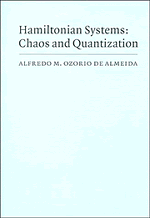9 - Periodic orbits in quantum mechanics
Published online by Cambridge University Press: 05 July 2011
Summary
The quantization of classically integrable systems relies explicitly on the invariant tori that foliate phase space. No distinction is made in the traditional semiclassical theory as to whether the motion on a quantized torus is periodic or only quasi-periodic. A strong perturbation may break up tori with incommensurate frequencies as well as those with periodic orbits. The only surviving smooth invariant manifolds, beyond the energy shell itself, will then be isolated periodic orbits. The semiclassical limit of stationary states must therefore bear some relation to these invariant curves. The uncertainty principle prevents us from attempting to tighten too closely the association between a given orbit and a specific state. In the last resort a state has to rely on a collection of periodic orbits or at least on a periodic orbit dressed with the local motion around it.
The basic instrument for evoking the contribution of periodic orbits is the semiclassical propagator for points that return to their initial positions. The classical orbits determining this propagator are dominated by the periodic orbits, in a way that is explained in section 9.1. On the other hand, the propagator can be represented as a sum over the intensities of the stationary wave functions. A local analysis establishes that individual wave intensities may exhibit strong ‘scars’ along some periodic orbits. Taking the trace of the propagator, we obtain a formula for the density of states as a sum over all the periodic orbits.
- Type
- Chapter
- Information
- Hamiltonian SystemsChaos and Quantization, pp. 208 - 231Publisher: Cambridge University PressPrint publication year: 1989



